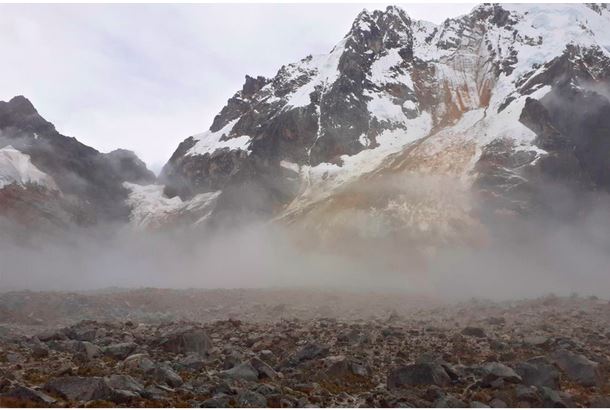27 February 2020
Breaking News: a catastrophic glacier collapse and mudflow in Salkantay, Peru
Posted by Dave Petley
Breaking News: a catastrophic glacier collapse and mudflow in Salkantay, Peru
On 23 February 2020 (corrected – this was erroneously reported as 24 February 2020) an enormous, catastrophic debris flow tore down the Salkantay River in Santa Teresa, Peru. This event has killed at least four people, with a further 13 reported to be missing. Given the magnitude of the flow, this number is probably uncertain.
The mudflow was captured in an extraordinary video posted to Youtube:-
.
A mudflow on this scale usually requires an extraordinary cause. Diario Correo in Peru has an explanation – this event was caused by glacial collapse on Salkantay mountain. This hypothesis is proposed by Oscar Vilca Gómez, who the article describes as a specialist in Hydrology and Glaciology. He visited the site site of the detachment as part of a research team from the National Institute for Glacier Research of the Ministry of Environment. They propose that an ice / rock avalanche detached from the mountain, crossed the Salkantay Cocha lake, and generated the huge debris flow.
The article includes the following image of the site:-

The site of the rock / ice avalanche at Salkantay in Peru. Image by Benito Moncado via Diario Correo Peru.
.
In first inspection this appears to be a wedge failure in the rock mass that has fragmented to generate the rock / ice avalanche. The photographer appears to be standing on the landslide deposit.
Salkantay (which also appears to be named Salcantay at times) is located at -13.340, -72.540. Salkantay Cocha lake appears to be at -13.342, -72.569. At the moment it is not clear as to which slope has failed to generate this ice-rock avalanche and debris flow. There is excellent Google Earth imagery of this area, so it should be possible to get a better understanding in due course.
At the moment details of this very significant event are somewhat unclear; I hope that more details will emerge. This event is reminiscent of the 2012 Gayari ice and rock avalanche in Pakistan and the 2017 Villa Santa Lucia landslide in Chile.


 Dave Petley is the Vice-Chancellor of the University of Hull in the United Kingdom. His blog provides commentary and analysis of landslide events occurring worldwide, including the landslides themselves, latest research, and conferences and meetings.
Dave Petley is the Vice-Chancellor of the University of Hull in the United Kingdom. His blog provides commentary and analysis of landslide events occurring worldwide, including the landslides themselves, latest research, and conferences and meetings.
Salkantay was also the source of a major debris flow in 1998 that formed a dam across and blocked the Vilcanota River and formed a deep impoundment, which led to the inundation of the upstream Macchu Picchu HEP underground powerhouse by the backwater flood. It put the scheme out of commission for three years and cost at least $200 million in damage and lost revenue.
I and my team investigated this in the field soon after the event.
Looking at the GE images the lake doesn’t appear to have much of a glacier in the slope above it. The resulting flood/mudflow (video) seems to be of a such a large volume that would argue that another part of the Salkantay let loose. The photo from the rock avalanche seem to suggest a source further east, perhaps the larger steep slope directly below the summit (lots of ice/snow), which shows evidence of past large landslides into the major southern drainage.
I was at Machu Picchu four years ago. We were going up the mountain to the site and I was thinking how beautiful the glaciers were in the distance. It was then our guide was telling us that in 60 years there would be no glaciers left in Peru. At the time I thought that couldn’t happen. If all the climate deniers like Trump continue to be in power this is around the corner. WE MUST DO SOMETHING NOW!
Its seems to be the end time prophecy as predicted before about 2020 and such events will likely to be held in else where throughout the world like sound coming from sky and changes in the color of many rivers into bloody red and many more.
Bakhtiar Ali
[No, we have evidence that these events have been occurring naturally throughout geological time. We are increasing the rate at which they occur though, primarily through driving global heating. D.]
The exact location seems to be at (-13.3434,-72.5321)
My daughter was trapped by the landslide. She was part of a group led by an expedition company on a hike to Machu Picchu. The event unfolded before their eyes. She was terrified. They were rescued by helicopters thanks to the US Consulate in Cusco. So thankful she and her group made it out.